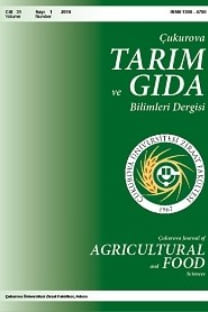Effects of Zinc Application on Some Important Yield and Quality Characteristics of Coriander (Coriandrum sativum L.)
Coriander, zinc, fruit yield, fatty acid composition, essential oil composition
Effects of Zinc Application on Some Important Yield and Quality Characteristics of Coriander (Coriandrum sativum L.)
Coriander, zinc, fruit yield, fatty acid composition, essential oil composition,
___
- Baytop, T. (1984). Türkiye’ de Bitkiler ile Tedavi. İstanbul Üniv. Yay. No;3255, Ecz. Fak. Yay. No: 40, İstanbul. (in Turkish) Beyzi, E., Gurbuz, B. (2014). Effect of different fruit sizes on essential oil ratio and components of coriander. J. Essent. Oil Bear. Plant 17:1175-1180.
- Beyzi, E., Güneş, A. (2017). The effects of boron application on essential oil components of coriander plant (Coriandrum sativum L.). J. Agric. Fac. Gaziosmanpasa Univ. 34:146-152.
- Beyzi, E., Güneş, A., Gürbüz, B. (2017a). Effects of humic acid treatments of yield, morphological characteristics and essential oil components of coriander (Coriandrum sativum L.). Res. J. Soil Biol. 9:1-8.
- Beyzi, E., Karaman, K., Güneş, A., Büyükkılıç Beyzi, S. (2017b). Change in some biochemical and bioactive properties and essential oil composition of coriander seed (Coriandrum sativum L.) varieties from Turkey. Ind. Crop. Prod. 109:74-78. Düzgüneş, O., Kesici, T., Kavuncu, O., Gürbüz F. (1987). Araştırma ve Deneme Metotları (İstatistik Metotları II). Ankara Üniversitesi Ziraat Fak. Yayınları: 1021, Ders Kitabı: 295, Ankara. (in Turkish)
- Erdoğdu Y. (2012). The effect of different doses of nitrogen on yield, yield charecteristics and essential oil content of coriander (Coriandrum sativum L.). Namık Kemal University Graduate School of Natural and Applied Sciences Department of Field Crops, Master of Thesis, 68 s.
- Ghasemi Pirbalouti, A., Salehi, S., Craker, L. (2017). Effect of drying methods on qualitative and quantitative properties of essential oil from the aerial parts of coriander. J. Med. Aromat. Plant Sci 4:35-40.
- Gökduman, G.A., Telci, İ. (2018). Determination of yield and quality characteristics of some coriander (Coriandrum sativum L.) genotypes in Isparta conditions. Süleyman Demirel Univ. J. Nat. Appl. Sci. 22:1165-1168.
- Gücük, F. (2014). Determination of agronomic and quality properties of coriander (Coriandrum sativum L.) varieties and hats sowed in winter and spring periods under Tokat Kazova conditions. Gaziosmanpaşa University Graduate School of Natural and Applied Sciences Department of Field Crops, Master of Thesis, Tokat, 57 s.
- Kan, Y. (2007). The effect of organic and inorganic fertilizer on yield and essential oil of coriander (Coriandrum sativum L.) growing in Konya ecological conditions. Univ. Selcuk J. Fac. Agric. 21:36-42.
- Katar, D. (2015). The effect of different sowing densities on yield and yield components of Coriander (Coriandrum sativum) cultivars under Ankara/Turkey ecological conditions. Biol Divers. Conserv. 8:173-180.
- Kaya, N., Yılmaz, G., Telci, İ. (2000). Agronomic and technological properties of coriander (Coriandrum sativum L.) populations planted on different dates. Turkish J. Agric. For. 24:355-364.
- Keskin, S. (2015). Agricultural and technological properties of some important culture species within the family Umbelliferae in Isparta ecological conditions. Süleyman Demirel University Graduate School of Applied and Natural Sciences Department of Field Crops, Master of Thesis, Isparta, 110 s.
- Khodadadi, M., Dehghani. H., Jalali Javaran, M., Christopher. J. T. (2016). Fruit yield, fatty and essential oils content genetics in coriander. Ind. Crop. Prod. 94:72-81.
- Kızıl, S., İpek, A. (2004). The Effects of different row spacing on yield, yield components and essential oil content of some coriander (Coriandrum sativum L.) lines. J. Agric. Sci. 10:237-244.
- Mandal, S., Mandal, M. (2015). Coriander (Coriandrum sativum L.) essential oil: Chemistry and biological activity. Asian Pac. J. Trop. Biomed. 5:421–428.
- Maret, W. (2013). Zinc biochemistry: From a single zinc enzyme to a key element of life. Advances in Nutrition: An Int. Rev. J. 4:82–91.
- Msaada, K., Hosni, K., Ben Taarit, M., Chahed, T., Kchouk, M.E., Marzouk, B. (2007). Changes on essential oil composition of coriander (Coriandrum sativum L.) fruits during three stages of maturity. Food Chem. 102:1131-1134. Özel, A., Güler, İ., Erden, K. (2010). Effect of different sowing time on essential oils components of coriander (Coriandrum sativum L.). Harran J. Agric. Food Sci. 14:55-62.
- Deshpande, P., Dapkekar, A., Oak, M. D., Paknikar, K. M., Rajwade, J. M. (2017). Zinc complexed chitosan/TPP nanoparticles: a promising micronutrient nanocarrier suited for foliar application. Carbohydr. Polym. 165:394–401.
- Ramadan, M. F., Mörsel, J. T. (2002). Oil composition of coriander (Coriandrum sativum L.) fruit-seeds. Eur. Food Res.Technol. 215:204-209.
- Sriti, J., Bettaieb, I., Bachrouch, O., Talou, T., Marzouk, B. (2019). Chemical composition and antioxidant activity of the coriander cake obtained by extrusion. Arab. J. Chem. 12:1765-1773.
- Tunçtürk, M. (2006). The effect of different seed rates on the yield, yield components and essential oil rate of coriander (Coriandrum sativum L.). Univ. Selcuk J. Fac. Agric. 20:58-62.
- Tunçtürk, R. (2011). Effects of Different Row Spacings on the Yield and Quality in Coriander (Coriandrum sativum L.) Cultivars. Yuzuncu Yıl Univ. J. Agric. Sci. 21:89-97.
- Ulutaş Deniz, E., Yeğenoğlu, S., Sözen Şahne, B., Gençler Özkan, A. M. (2018). Kişniş (Coriandrum sativum L.) üzerine bir derleme. Marmara Pharm. J. 22:15-28. (in Turkish)
- Zoubiri, S., Baaliouamer, A. (2010). Essential oil composition of Coriandrum sativum seed cultivated in Algeria as food grains protectant. Food Chem. 122:1226-1228.
- ISSN: 2636-7874
- Başlangıç: 1973
- Yayıncı: Çukurova Üniversitesi
Besi Hayvanlarında Yaralanmalar ve Önleme Yolları
Gulbahar ARIKAN, Saime Büşra FİDANCI, Orhan BOZAN, Nuket ONELGE
Hakan DOYGUN, Dilay ZÜLKADİROĞLU, Ilgaz EKŞİ
Farklı Üretim Yöntemlerinin Üretici Gelirine Katkısı: Türkiye'de Çilek Üretimi
Burak ÖZTORNACI, Arzu SEÇER, Faruk EMEKSİZ
Üniversite Öğrencilerinin Stres Durumları ile Fruktoz ve İşlenmiş Besin Tüketimi Arasındaki İlişki
M.merve TENGİLİMOĞLU METİN, Ebru MELEKOĞLU
Dürdane MART, Meltem TÜRKERİ, Ramazan AKIN, Derya YUCEL, Sezgin MART
Cem AYDIN, Unal KURT, Yalçin KAYA
Farklı Üretim Yöntemlerinin Üretici Gelirine Katkısı: Türkiye'de Çilek Üretimi
Burak ÖZTORNACI, Arzu SEÇER, Faruk EMEKSİZ
Topraksız Tarımda Kullanılan Atıkların Marul ve Maydanoz Fidesi Yetiştiriciliğine Etkileri
Salim TAŞDELEN, Aslıhan ÇİLİNGİR TÜTÜNCÜ, Harun ÖZER
Farklı Tarımsal Atıkların Ganoderma lucidum Yetiştiriciliğinde Verim ve Kalite Üzerine Etkisi
Yasin Burak HAL, Mahmut YARAR, Ecem KARA, Gökhan BAKTEMUR, Hatıra TAŞKIN
